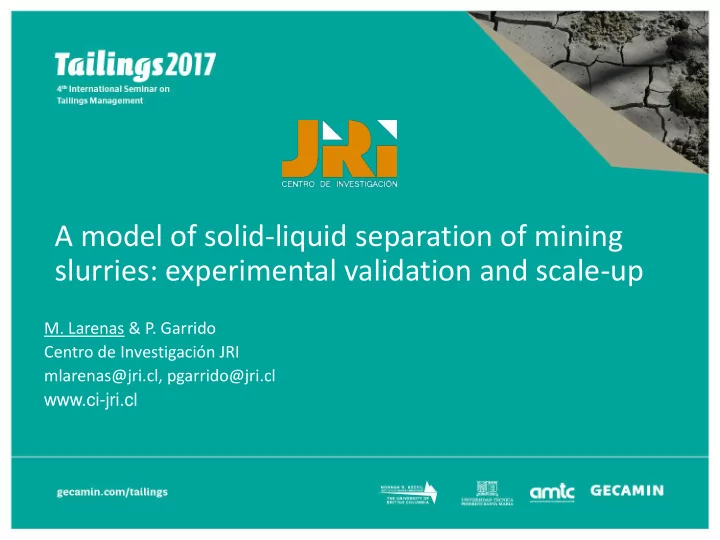

A model of solid-liquid separation of mining slurries: experimental validation and scale-up M. Larenas & P. Garrido Centro de Investigación JRI mlarenas@jri.cl, pgarrido@jri.cl www.ci-jri.cl
Contents Context The model Experimental validation Scale-up Conclusions
Thickening in the mining industry Main goals: Water recovery (dewatering) Increase solids concentration Thickened tailings for final disposal Complex process in theoretical and operational aspects Need to understand phenomenology Tailings thickener, Minera Los Pelambres
Thickening in the mining industry Operational difficulties: Low discharge concentration Bad quality supernatant (overflow) High torque, embankment Requirements of design conditions are not met 31% 28% 28% 26% Copper tailings thickener 26% Frequency diagram 23% 20% Operational data 2012-2014 18% Frecuencia 17% Frequency Source: JRI 15% 13% 10% Average=117.5 Ktpd 10% Nominal=142.5 Ktdp 7% 8% < 4% 5% 4% 4% 3% 3% 1% 0% 0% 0% 60.000 70.000 80.000 90.000 100.000 110.000 120.000 130.000 140.000 150.000 160.000 170.000
Contents Context The model Experimental validation Scale-up Conclusions
The mathematical model Bürger et al., “A model of continuous sedimentation of flocculated suspensions in clarifier-thickener units', SIAM J. Appl. Math. 65 (2005), 882-940. 𝑣 0 1 fluxes consolidation sedimentation advection compression
The mathematical model Geometry Thickener Simulator 𝑦
The mathematical model Batch test: 35 30 25 Interface height [cm] 20 15 10 5 0 0 5 10 15 20 25 Time [min] Interface height vs time (9% w/w)
The mathematical model Settling velocity Effective solid stress 35 4000 3500 30 3000 25 Settling velocity [cm/min] Effective solid stress [Pa] 2500 20 2000 15 1500 10 1000 5 500 0 0 0 0.05 0.1 0.15 0.2 0.25 0.3 0.35 0 0.1 0.2 0.3 0.4 0.5 0.6 0.7 Concentration w/w Concentration w/w
Contents Context The model Experimental validation Scale-up Conclusions
Experimental validation: batch operation
Experimental validation: batch operation
Experimental validation: continuous operation 100 90 80 70 60 Height [cm] 50 40 30 20 10 0 0 50 100 150 200 250 Time [min] 0.54 Discharge concentration 0.52 0.5 0.48 0.46 0.44 Column height 1 [m] 0.42 UA 0,1 [m 2 /tpd] 0.4 Feed 12 [%w/w] 0 50 100 150 200 250 Time [min] Discharge (design) 52 [%w/w] Flocculant dose 15 [gpt]
Experimental validation: continuous operation
Contents Context The model Experimental validation Scale-up Conclusions
Scaling-up [tpd] Total production 22,000 [%w/w] Feed concentration 31 Feed [%w/w] Dilution concentration 6 [gr/cm 3 ] Solid density 2.69 [gpt] Flocculant dose 15 [m 2 /tpd] Unitary area (design) 0.0890 Discharge Discharge concentration (design) 56 [%w/w] [Pa] Yield stress <50 [ft·lb/ft 2 ] Torque K-factor 54 Torque [-] Safety factor Factor K 5.35 Torque 1,440,000 [ft·lb] [m] Diameter 50 Dimensions [m] Total height 10 [°] Base slope 14 50 m 10 m 14°
Scaling-up Steady state (after ~8 h): 4,1 m Production 22,000 [tpd] Solids Feed concentration 31 [%w/w] Discharge concentration 56 [%w/w] 0,567 Feed flow [m 3 /s] Water 0,340 Supernatant flow [m 3 /s] 60 [ %] Recovery rate
Scaling-up
Contents Context The model Experimental validation Scale-up Conclusions
Integrated approach 1: Laboratory 2: Semi-pilot testing 3: Modeling 4: Implementation Carry out on-site Characterization of Settling column (1-4 m) Design validation and actions following representative samples to evaluate performance identify operational according to mining plan at reduced scale recommentations improvements Exhaustive analysis of thickener perfomance
Conclusions 1. The proposed numerical simulator facilitates the assessment of different thickener dimensions and operational scenarios. 2. The mathematical model is flexible and can be applied to general solid-liquid suspensions (ore concentrate, mine tailings, wastewater). 3. Extended theoretical studies, experimental considerations and the addition of other relevant phenomena, will contribute towards the consolidation of the mathematical model. 4. Laboratory tests (characterization of slurries), pilot-testing and numerical simulations can be put together into an integrated system for the design and optimization of thickener operation at industrial scale.
www.ci-jri.cl CI-JRI@jri.cl
Recommend
More recommend